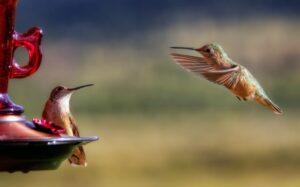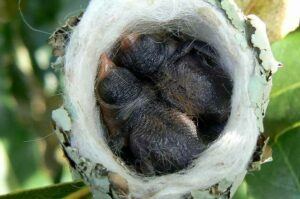Hummingbirds are not cavity nesters like woodpeckers, and they do not care for nesting boxes, rather, they build their nests in thick bushes and forked branches of sheltered trees. Hummingbird nests are as tiny as you would imagine them to be. There is some difference between how the nests of different hummingbird species look, however with some bigger, some at higher altitudes, and some having multiple structures.
WHY DO HUMMINGBIRDS NEST IN BUSHES AND SHELTERED TREES?

Hummingbirds choose to nest where they do because their young are so small that they must be protected from the elements while remaining hidden. The female bird builds the nest but may try nesting in a few different locations before deciding on a location to complete a nest and lay eggs.
One popular location for hummingbirds to nest is in thickets where there is a lot of dense and coarse coverage. This coverage keeps their tiny nests protected from the elements, and the thorny thicket provides added protection against predators.
Hummingbirds can build their nests anywhere from three to sixty feet off the ground. Many hummingbirds prefer lower nest sites, but the Magnificent hummingbird prefers building at higher altitudes.
While most hummingbirds will nest in bushes and sheltered trees, occasionally, a bird may choose a very unusual place to nest. For example, sometimes they build nests inside porch lights or in basketball nets!
A female hummingbird can spend hours a day for a whole week collecting materials to build a nest; most frequently, she will choose materials like moss, feathers, spider silk, leaves, dandelion down, lichen, and bark.
Spider silk may sound like a peculiar material, but it is quite an ingenious addition because it allows the next to expand to accommodate eggs and later hatchlings!
WHAT DO HUMMINGBIRD NESTS LOOK LIKE?
Hummingbird nests do not all look alike, but they are often around one and a half inches wide and around the same size as a golf ball! Some nests will be deeper than others.
The female hummingbird will use the material she collected to build a small cup-shaped nest with a rim that turns inward. This rim helps to keep her eggs inside the nest even when the weather gets a little rough!
Once the nest is complete, the female hummingbird will frequently pick fluffy plant material like cotton fibers (and even dryer lint) as soft padding to encase their fragile eggs.
How fragile are hummingbird eggs? Each one is about the size of a Tic-Tac!
DOES THE MALE HUMMINGBIRD PLAY ANY ROLE IN NESTING?

No. In fact, the female will begin building her nest as soon as she is ready to mate, so the male may not be in the picture when the female starts nesting.
As for the male, once he has mated with the female, his role is complete, and he leaves never to see the eggs hatch. The female will incubate her eggs and raise her young by herself. She will incubate her eggs for between eleven and twenty-two days (depending on the hummingbird species) and then raising her young for two to three weeks.
Some multi-tasking hummingbird moms will even build a second nest and lay eggs in that while still raising their young in the original nest!
IS IT RARE TO SEE A HUMMINGBIRD NEST?
It is not often that you will see a hummingbird nest. One reason for this is because the nests are usually very well hidden. If their nests were not well hidden, these tiny birds would not stand a chance against predators like crows and ravens.
A second reason you do not regularly see hummingbird nests is that they can be very well camouflaged. A nest may look to be part of the tree bark or have greenery woven in, so it blends in with the bush or tree.
THE DIFFERENT NESTING STYLES OF HUMMINGBIRD SPECIES

There are over three hundred hummingbird species, so it is not surprising that there are differences between how nests look. Ornithologist Hal Harrison spent decades studying hummingbirds and documented some of those differences.
He found that:
- The Anna’s hummingbird builds a basic platform where she lays her eggs and then, while the eggs incubate, she builds the nest around them. This creates a more “custom fit.”
- The black-chinned hummingbird builds a cup-style nest, but the cup tends to be deeper than the nests of other hummingbird species.
- The blue-throated hummingbird is one of the peculiar hummingbirds that like to nest in unusual places. Their nests are often built on electrical wiring outside homes.
- The broad-billed hummingbird is another strange nester and likes to build on clotheslines. Their nests are not as tightly woven as other hummingbird species
- Broad-tailed hummingbirds do not move nesting sites like other hummingbird species, they regularly come back to the same spot each year.
- Calliope hummingbirds build tall nests, often building on a pinecone and building multiple nests on top of each other!
- Costa’s hummingbirds choose sites that they like and build nests in close proximity to each other.
- Magnificent hummingbirds build their nests at higher altitudes than other hummingbirds. Their nests are also the largest of the North American hummingbird nests.
- Ruby-throated hummingbird females use spider silk to “stick” their nest to branches. It is also not uncommon for this hummingbird species to still be feeding her young in a nest while laying more eggs in a second nest!
Conclusion
Hopefully this article has given you some solid information on what on how, where and what nests different hummingbirds build for their newborns.
These little flying critters have the multitude of unique methods for building
References
https://www.thespruce.com/all-about-hummingbird-nests-386644
https://www.birdsandblooms.com/birding/attracting-hummingbirds/hummingbird-nest-facts/
https://www.sweet-seed.com/hummingbirds/how-many-times-do-hummingbirds-nest-in-a-year/
Amhil Khan, a dedicated nature enthusiast and the founder of BirdsOfTheWild.com, is a passionate advocate for the captivating world of avian wonders. With a deep-seated curiosity about the intricate lives of birds, Amhil’s journey began as a fascination and has evolved into a mission to inspire others to appreciate and protect these magnificent creatures.
Amhil’s love for birds led to the creation of Birds of the Wild, a platform where his expertise in ornithology, coupled with his captivating storytelling, provides readers with an immersive and educational experience. Through his lens and words, he captures the essence of birds in their natural habitats, offering a glimpse into their behaviors, migrations, and the ecosystems they inhabit.

